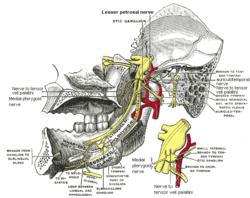Otic ganglion
| Otic ganglion | |
|---|---|

Mandibular division of trigeminal nerve, seen from the middle line. The small figure is an enlarged view of the otic ganglion.
|
|

The otic ganglion and its branches.
|
|
| Details | |
| From | lesser petrosal nerve |
| Innervates | parotid gland |
| Identifiers | |
| Latin | ganglion oticum |
| Dorlands /Elsevier |
g_02/12384730 |
| TA | A14.3.02.014 |
| FMA | 6967 |
|
Anatomical terms of neuroanatomy
[]
|
|
The otic ganglion is a small parasympathetic ganglion located immediately below the foramen ovale in the infratemporal fossa and on the medial surface of the mandibular nerve. It is functionally associated with the glossopharyngeal nerve and innervates the parotid gland for salivation.
It is one of four parasympathetic ganglia of the head and neck. The others are the ciliary ganglion, the submandibular ganglion and the pterygopalatine ganglion.
The otic ganglion is a small (2-3 mm), oval shaped, flattened parasympathetic ganglion of a reddish-gray color, located immediately below the foramen ovale in the infratemporal fossa and on the medial surface of the mandibular nerve.
It is in relation, laterally, with the trunk of the mandibular nerve at the point where the motor and sensory roots join; medially, with the cartilaginous part of the auditory tube , and the origin of the tensor veli palatini; posteriorly, with the middle meningeal artery. It surrounds the origin of the nerve to the medial pterygoid.
The preganglionic parasympathetic fibres originate in the inferior salivatory nucleus of the glossopharyngeal nerve. They leave the glossopharyngeal nerve by its tympanic branch and then pass via the tympanic plexus and the lesser petrosal nerve to the otic ganglion. Here, the fibres synapse, and the postganglionic fibers pass by communicating branches to the auriculotemporal nerve, which conveys them to the parotid gland. They produce vasodilator and secretomotor effects.
...
Wikipedia
